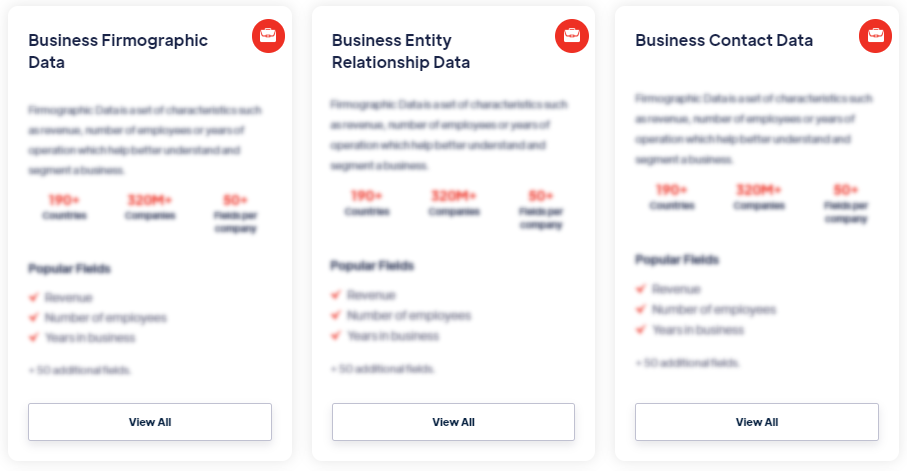Best
ESG Data
Products
ESG Data refers to information related to Environmental, Social, and Governance factors that are used to assess the sustainability and ethical performance of companies, investments, and organizations. It includes data points and indicators that provide insights into a company's environmental impact, social responsibility, and corporate governance practices. Read more
Our Data Integrations


Request Data Sample for
ESG Data

Browse the Data Marketplace

Frequently Asked Questions
1. What is ESG Data?
ESG Data refers to
information related to Environmental, Social, and Governance
factors that are used to assess the sustainability and ethical
performance of companies, investments, and organizations. It
includes data points and indicators that provide insights into a
company's environmental impact, social responsibility, and
corporate governance practices.
2. Why is ESG Data important?
ESG Data is
important because it allows investors, stakeholders, and
organizations to evaluate the broader impact of companies and
investments beyond financial performance. It helps measure and
analyze the sustainability practices, social impact, and
governance standards of companies, enabling informed
decision-making that aligns with environmental and social
values.
3. What types of data are included in ESG Data?
ESG Data encompasses a wide range of information. Environmental
data may include metrics such as carbon emissions, energy
consumption, waste management, and resource usage. Social data
can cover aspects like labor standards, employee diversity,
community impact, and human rights. Governance data focuses on
factors such as board composition, executive compensation,
transparency, and ethical business practices.
4. How is ESG Data collected and evaluated?
ESG Data is collected from various sources, including company
reports, regulatory filings, sustainability reports, third-party
databases, and industry surveys. Rating agencies, research
firms, and specialized data providers analyze and evaluate this
data using specific methodologies and frameworks. They assign
ESG scores or ratings to companies, allowing for comparisons and
benchmarking.
5. How is ESG Data used?
ESG Data is used
by investors, asset managers, and financial institutions to
assess the sustainability and ethical performance of companies
and investments. It helps integrate environmental, social, and
governance factors into investment decisions, risk management,
and portfolio construction. ESG Data also enables companies to
monitor and improve their own ESG performance and communicate it
to stakeholders.
6. What are the challenges with ESG Data?
Challenges with ESG Data include data quality and consistency,
as reporting practices and disclosure standards can vary across
companies and industries. There may be a lack of standardized
metrics and definitions, making it difficult to compare data
across companies or regions. Additionally, data gaps and
limitations in certain areas, such as social impact assessment
or small and medium-sized enterprises (SMEs), can pose
challenges in obtaining comprehensive ESG insights.
7. How can ESG Data be improved?
Improving
ESG Data requires efforts from various stakeholders. Companies
can enhance their ESG reporting and disclosure practices,
providing more detailed and standardized information. Regulatory
bodies can establish clearer reporting guidelines and
requirements. Collaboration between data providers, rating
agencies, and investors can drive the development of consistent
methodologies and metrics. Advancements in technology, such as
natural language processing and machine learning, can help
automate data collection and analysis, improving efficiency and
accuracy.
